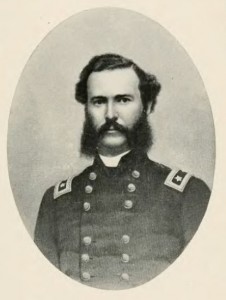Herron, Francis J.
 Francis J. Herron was a banker in Dubuque, Iowa, before the Civil War. As a Captain, he fought in the Battle of Wilson’s Creek, on August 10, 1861, then soon returned to Iowa to help field the 9th Regiment, Iowa Volunteer Infantry. The 9th Iowa’s first assignment was to guard the railroad in Pacific, Missouri, and Herron and the regiment arrived on October 11, 1861.
Francis J. Herron was a banker in Dubuque, Iowa, before the Civil War. As a Captain, he fought in the Battle of Wilson’s Creek, on August 10, 1861, then soon returned to Iowa to help field the 9th Regiment, Iowa Volunteer Infantry. The 9th Iowa’s first assignment was to guard the railroad in Pacific, Missouri, and Herron and the regiment arrived on October 11, 1861.
Wilson’s Creek, near Springfield, is on the Wire Road, as were the Arkansas battles at Pea Ridge and Prairie Grove. At Pea Ridge in 1862, Herron was wounded and captured, and received the Medal of Honor and a promotion to Brigadier General for his actions there. On December 3, 1862, Herron commanded a division of the Union Army of the Frontier, camped just south of Springfield. Summoned to northwest Arkansas, Herron moved down the Wire Road and arrived with 3500 troops to save the Union Army at Prairie Grove. His march, 110 miles in less than three days, was the greatest forced march of the Civil War. His actions there brought Herron a promotion to Major General, and he was (at age 25) the youngest man to wear 2 stars since Lafayette.

